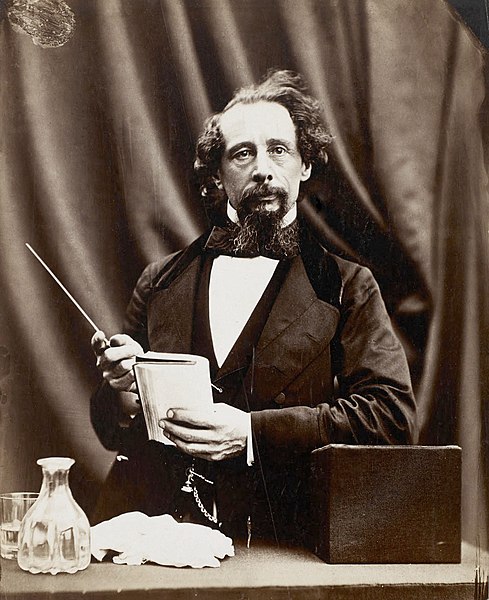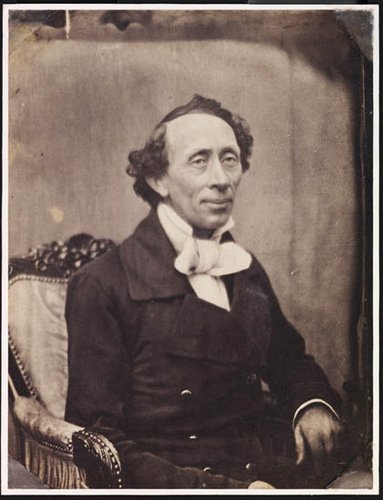In the summer of 1857, Hans Christian Andersen visited Charles Dickens, spending an ill-fated five weeks at his home, Gads Hill, Kent. During the visit they made frequent trips to London where Andersen got to experience the city’s public transportation system firsthand. On one of these trips a peculiar incident occurred which shows how locals and tourists can experience public transportation in different ways.
I was recently involved in the production of a play in Turku, Finland. It was entitled H.C. – Poeettinen kohtaaminen Englanissa (which roughly translates to “H.C. – A poetic encounter in England”) and was written and directed by local playwright, Marja Susi.
The encounter to which the title refers was between the Dickens and Andersen, and the play evolved around Andersen’s disastrous five-week visit to Dickens in the summer of 1857 which effectively put an end to whatever friendship existed between the two.
There’s a scene in the play where Andersen (played by Timo Väntsi) gets ready to depart from the Dickens home in Kent to London by stuffing a notebook, some letters, a pair scissors and a few other things into the boots he’s wearing while a dumbfounded Dickens (played by Raimo Karppinen) looks on.
The scene played well, I think, conveying Andersen’s peculiar personality to an audience who could share Dickens’ bewilderment while still being free to laugh at the spectacle – which happened on every performance I witnessed.
Overall, I think the play was very good. Susi and the actors managed to capture the writers’ friendship in a way that was both funny and moving while maintaining a high level of historical accuracy. But in this scene, they had translated a single occurrence into a habit.
Andersen did not normally stuff his belongings into his boots. It seems only to have happened once in connection with a cab ride in London, and to me this incident illustrates in miniature how locals and tourists can experience public transportation in different ways. According to Andersen’s diary, the episode took place on 29 June. Dickens gave his version a couple of times, with the best description coming in a letter to William Jerdan on 21 July:

Photo by Herbert Watkins, 1858
Source: Wikimedia Commons
But whenever he [Andersen] got to London, he got into wild entanglements of cabs and Sherry, and never seemed to get out of them again until he came back here [Gads Hill], and cut out paper into all sorts of patterns, and gathered the strangest little nosegays in the woods. […] One day he came home to Tavistock House [Dickens’ London residence], apparently suffering from corns that had rippened in two hours. It turned out that a cab driver had brought him from the City, by way of the new unfinished thoroughfare through Clerkenwell. Satisfied that the cabman was bent on robbery and murder, he had put his watch and money in his boots – together with a Bradshaw [the travel guide], a pocket-book, a pair of scissors, a pen-knife, a book or two, a few letters of introduction, and some other miscellaneous property.
(Bredsdorff, p.122-123).
Dickens had grown exceedingly tired of Andersen during the summer – it is told that, upon Andersen’s departure, he wrote on a mirror at Gads Hill that “Hans Andersen slept in this room for five weeks – which seemed to the family AGES!” (Bredsdorff, p.124) – and perhaps that is why he seems to play the anecdote for laughs. Bewilderment, annoyance and, perhaps, scorn, characterises Dickens’ retelling of the story which, while it is amusing, does seem callous when looking at the incident from Andersen’s perspective.

Photo by John Thomson, 1877
Source: Wikimedia Commons
Andersen describes it in his diary like this:
Today with the train from Higham to London elleven o’clock; […] At London Bridge I was separated from the [Dickens] family, took a cab, the cabman drove me to one of the seedy neighbourhoods and I thought he wanted to do me harm, but I got home alright.
(Bredsdorff, p.54; translated from Danish by blog author)
That he doesn’t mention his boots here is not surprising if it’s true, as Dickens tells in another letter, that, upon Andersen’s return, it was a “tremendous business to unpack him and get them off” (Bredsdorff, p.94). The embarrassment of causing a kerfuffle in the Dickens household no doubt added insult to injury.
Andersen had been to London before and had acquaintances there, but it’s safe to say that he did not have the kind of intimate knowledge of the city’s different areas needed to feel comfortable once a cab driver took him down unknown streets. In addition, Andersen’s English was very poor. That fact was certainly one of the reasons his visit Charles Dickens (1812-1870)
Photo by Herbert Watkins, 1858
Source: Wikipedia Commonsbecame so intolerable to Dickens, but it must have made this cab ride highly exasperating for a man of Andersen’s sensitivity.

Source: www.ts.fi
The diary entry tells us that Andersen was travelling with Dickens and his family, but, in fact, got lost. (This is confirmed by Dickens.) Alone in the metropolis, he decides to get on a cab which then goes through areas that to Andersen looks squalid and dangerous. Unable to properly communicate with a driver (who probably also spoke a local dialect), he became anxious and afraid, and took a rather odd and, most likely, panicked decision to safeguard his belongings.
It is an amusing story. But it works better when, as in Susi’s play, it is made into a habitual peculiarity, a quirk. Dickens made a joke of a single incident that must have been a cause of genuine fear and he did it with little sympathy and understanding for his foreign guest’s situation at the time.
Andersen and Dickens’ friendship is discussed in many places, including most standard biographies.
Sources:
Bredsdorff, Elias. 1951. H.C. Andersen og Charles Dickens. Et Venskab og dets Opløsning. København: Rosenkilde og Baggers Forlag.













